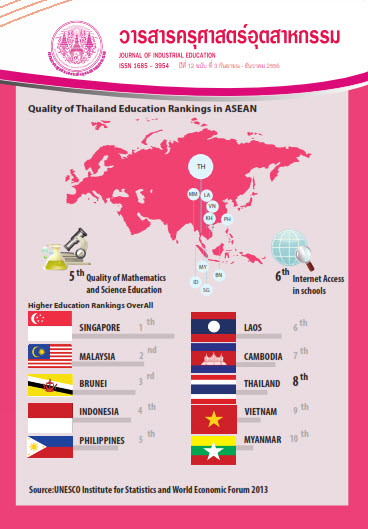A study on the potential development and evolution of handicrafts made from jute within a community in Northeast Thailand.
Keywords:
potential to develop handicraft skills and techniques, new theory in natural dyeing production processes, natural dyeing processes, jute, development of products from the jute familyAbstract
A study on the potential development and evolution of handicrafts made from jute within a community in Northeast Thailand is aimed 1) to study selected communities that grow jute 2) to study handicraft skills, knowledge and processes 3) to develop and create new theories 4) to apply knowledge in product design to create added value 5) to evaluate and test the possibilities of creating products from these concepts. For the research, the researcher has selected to study the handicraft skills and knowledge from communities in Northeast Thailand to be used and adapted in developing new products made from jute.
The research categorized communities in the northeast into four groups: 1) communities which grew jute 2) communities which made handicrafts from jute and 3) communities which grew jute and made handicrafts from the plant 4) communities which certified Thai community product standard. In the initial survey, the researcher found that there were six communities in the region that matched the fundamental requirements for studying the potential of handicraft skills and knowledge. The requirements were having sufficient raw material resources and handicraft skills. However, the researcher selected the jute fibre handicraft group of Baan Tok Pan (Kloom Mae Baan Sai Yai Por Baan Tok Pan), located at Ban Koh Muang Sub-district, Muang District, Khon Kaen as the subject for the research.
For the research, the researcher found that jute had the highest potential to develop products for sale in the market. The plant’s fibres could be used to produce a wide range of products. The fibres are durable and soft while the plant is easy to cultivate and grow. The researcher also studied the use of other material fibres in the region such as cotton, kapok, bananas, pineapples, coconut, bamboo, galangal and lotus to develop handicrafts made from jute. The research, hence, focusses on jute as the main material and case studies as there was only a small amount of research on the plant, and products made from the plant.
With respect to the use of the research to develop a wider range of products and new eco-friendly production methods, the researcher found that jute could be knitted, sewn and used to create home wares, decorative products as well as souvenirs. The jute fibres could be used as an alternative for handicraft manufacturers and consumers. Lastly, Entrepreneurs and relevant businesses could use this research in developing products and businesses as well as promoting the use of cultural capital to create new business opportunities suitable to different communities.
References
[2] อิทธิพล พันธ์ธรรม. 2555. สถาบันอุตสาหกรรมสิ่งทอชูงานวิจัยนำของเหลือใช้จากภาคเกษตรแปรรูปสู่เส้นใยธรรมชาติเพิ่มมูลค่าสิ่งทอไทยไปตลาดโลก. [ออนไลน์]. เข้าถึงได้จาก: http://w.efinancethai.com. (วันที่ค้นข้อมูล: 10 มกราคม 2556).
[3] กระทรวงเกษตรและสหกรณ์. สำนักงานเศรษฐกิจการเกษตร 2543. สถิติการเกษตรของประเทศไทย ปีเพาะปลูก 2525/26, 2527/28, 2536/36 และ 2543/44.
[4] กัลยกร จันทร์สาขา พิชัย สดภิบาล และอุดมศักดิ์ สาริบุตร. 2554. ศึกษาการออกแบบผลิตภัณฑ์ศิลปหัตถกรรมประเภทงานจักสาน ไม้ไผ่ลายขิด กลุ่มผู้ผลิตบ้านหนองสระพัง ตำบลหนองห้าง อำเภอกุฉินารายณ์ จังหวัดกาฬสินธุ์. วารสารครุศาสตร์ อุตสาหกรรม, 10(3), น. 337-346.
[5] สํานักงานมาตรฐานอุตสาหกรรม. 2555. มาตรฐานผลิตภัณฑ์ชุมชน. [ออนไลน์]. เข้าถึงได้จาก: www.tisi.go.th (วันที่ค้นข้อมูล: 10 พฤศจิกายน 2555).
[6] สำนักนายกรัฐมนตรี. สำนักงานคณะกรรมการพัฒนาการเศรษฐกิจและสังคมแห่งชาติ. 2555. แผนพัฒนาเศรษฐกิจและสังคมแห่งชาติ ฉบับที่11 (2555-2559). [ออนไลน์]. เข้าถึงได้จาก: http://www.nesdb.go.th/Default.aspx? tabid=395 (วันที่ค้นข้อมูล: 10 พฤศจิกายน 2555)
[7] ไชยยศ เพชระบูรณิน. 2536. ปอแก้วปอกระเจาในสารานุกรมไทยสำหรับเยาวชน โดยพระราชประสงค์ ในพระบาทสมเด็จพระเจ้าอยู่หัว. เล่มที่ 17
Downloads
Published
How to Cite
Issue
Section
License
"The opinions and contents including the words in papers are responsibility by the authors."
"ข้อคิดเห็น เนื้อหา รวมทั้งการใช้ภาษาในบทความถือเป็นความรับผิดชอบของผู้เขียน"



